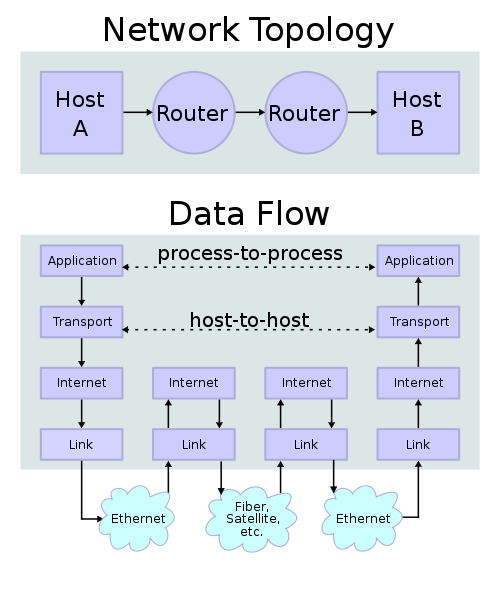IP networks are the largest standardized data transfer networks worldwide. These networks can be found in almost every business and home and are used for file transfer, storage, printing, etc. The Internet Protocol over Ethernet (802.x) networks is widely understood and supported. It is robust, inexpensive, well-documented, readily deployed, and nearly universal. Many equipment manufacturers such as Comrex, Telos, and Wheatstone have developed audio equipment that uses IP networks to transfer and route audio within and between facilities.

Audio enters the system via an analog-to-digital converter (A/D converter), often a sound card, at which point a computer program stores it as a file. These files can be .wav, .mp3, .mp4, apt-X, or some other format. Once the audio is converted to a digital data format, it is handled much the same way as any other digital data.
IP stands for “Internet Protocol,” which is a communications protocol for transmitting data between computers connected to area networks. In conjunction with a transmission protocol, either TCP (Transmission Control Protocol) or UDP (User Datagram Protocol) IP forms what is known as the Internet Protocol Suit known as TCP/IP. The Internet Protocol Suit contains four layers:
- Application layer – This is the protocol that contains the end-use data. Examples of these would be HTTP, FTP, DCHP, SMTP, POP3, etc. Telos Systems uses its own application called “Livewire” for its equipment. Wheatstone uses “WHEATNET.” Digigram uses “Ethersound.” This is an important distinction.
- Transfer layer – This contains the TCP or UDP header information that contains such things as transmitting, and receiving ports, checksum value for error checking, etc. It is responsible for establishing a pathway through multiple IP networks, flow control, congestion routing, error checking, and retransmission. TCP allows for multiple IP packets to be strung together for transmission, increasing transfer rate and efficiency.
- Internet layer – This is responsible for transporting data packets across networks using unique addresses (IP addresses).
- Link Layer – This can also be called the physical layer, using Ethernet (802.x), DSL, ISDN, and other methods. The physical layer also means things like network cards, sound cards, wiring, switches, and routers.
Advantages:
An IP network can be established to transmit data over almost any path length and across multiple link layer protocols. Audio, converted to data can thus be transmitted around the world, reassembled, and listened to with no degradation. Broadband internet connections using a cable, DSL, ISDN, or T-1 circuits can be pressed into service as STL’s, ICR’s, and TSL’s. This translates to fast deployment; no STL coordination or licensing issues, no antennas to install if on a wired network. Cost reductions are also realized when considering this technology over dedicated point-to-point TELCO T-1’s. Additionally, license-free spread spectrum radios that have either DS-1 or 10baseT Ethernet ports can be used, provided an interference-free path is available.
IP audio within facilities can also be employed with some brands of consoles and soundcards, thus greatly reducing audio wiring and distribution systems and corresponding expenses. As network speeds increase, file transfer speeds and capacity also increase.
Disadvantages:
Dissimilar protocols in the application layer mean a facility can’t plug a Barix box into a Telos Xtream IP and make it work. There are likely hundreds of application layer protocols, most of which do not speak to each other. At some point in the future, an IP audio standard, like the digital audio AES/EBU may appear, which will allow equipment cross-connections.
Additionally, the quality of the physical layer can degrade performance over congested networks. The installations must be carefully completed to realize the full bandwidth capacities of cables, patch panels, patch cords, etc. Even something as little as stepping on a Category 6 cable during installation can degrade its high-end performance curve. The cable should be adequately supported, not kinked, and not stretched (excessive pulling force) during installation.
TCP/IP reliability is another disadvantage over formats like ATM. In a TCP/IP network, no central monitoring or performance check system is available. TCP/IP is what could be called a “broadcast” protocol. That is to say, it is sent out with a best-effort delivery and no delivery confirmation. Therefore, it is referred to as a connection-less protocol and in network architecture parlance, an unreliable network. Lack of reliability allows any of these faults to occur; data corruption, lost data packets, duplicate arrival, out of order data packets. That is not to say that is does not work, merely that there is no alarm generated if an IP network begins to lose data. Of course, the loss of data will affect the reconstruction of the audio.
Finally, latency can become an issue over longer paths. Every A/D converter, Network Interface Card (NIC), cable, patch panel, router, etc has some latency in its circuitry. These delays are additive and dependent on the length of the path and the number of devices in it.
Provided care is taken during design and installation, AOIP networks can work flawlessly. Stocking adequate spare parts, things like ethernet switches, NICs, patch cables and a means to test wiring and network components is a requirement for AOIP facilities.


